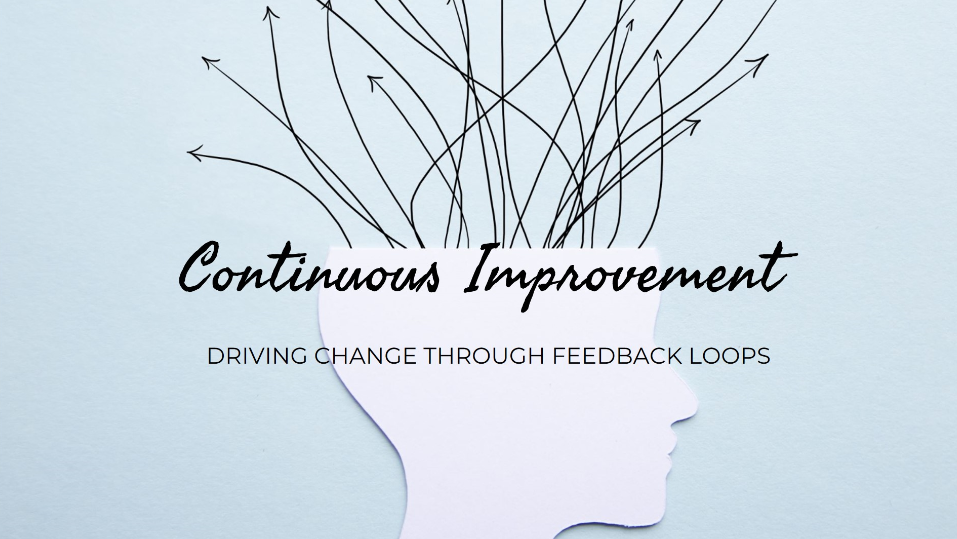
Introduction
In an era where businesses must adapt rapidly to stay competitive, effective change management has become essential. Central to this process is the concept of continuous improvement, which focuses on ongoing enhancement of processes, products, and services. Coupled with feedback loops, continuous improvement forms a dynamic framework that not only addresses current challenges but also anticipates future needs. This article delves into the importance of continuous improvement and feedback loops in change management, the strategies for implementing them, and the benefits they bring to organizations.
Understanding Continuous Improvement
Continuous improvement refers to an ongoing effort to enhance products, services, or processes incrementally over time. Unlike one-time changes, continuous improvement is about fostering a culture that encourages innovation and efficiency at every level of the organization.
Principles of Continuous Improvement
- Incremental Changes:
- Focus on small, manageable changes rather than sweeping transformations. Incremental improvements can lead to significant results over time.
- Employee Involvement:
- Encourage all employees to contribute ideas and solutions for improvement. Engaged employees often have valuable insights into the processes they work with daily.
- Data-Driven Decision Making:
- Use data and metrics to identify areas for improvement. Collecting and analyzing data helps organizations understand performance and prioritize initiatives.
- Standardization:
- Once improvements are identified and implemented, standardize the new processes to ensure consistency and sustainability. This forms the foundation for future enhancements.
- Adaptability:
- Embrace change as a constant. Continuous improvement is about being flexible and open to modifying practices based on feedback and changing circumstances.
The Role of Feedback Loops in Change Management
Feedback loops are processes through which information about the results of an action is used to modify subsequent actions. In change management, feedback loops provide essential insights into the effectiveness of initiatives, enabling organizations to adapt and refine their approaches.
Importance of Feedback Loops
- Real-Time Insights:
- Feedback loops allow organizations to gather real-time data on the impact of changes, facilitating quicker decision-making and adjustments.
- Enhanced Employee Engagement:
- Involving employees in feedback processes demonstrates that their opinions are valued, fostering a culture of trust and collaboration.
- Continuous Learning:
- Feedback loops promote a culture of continuous learning, where organizations learn from both successes and failures to improve future initiatives.
- Alignment with Objectives:
- Regular feedback ensures that initiatives remain aligned with organizational goals and objectives, enabling timely adjustments as needed.
Strategies for Implementing Continuous Improvement and Feedback Loops
- Establish a Clear Framework:
- Define a structured approach for continuous improvement and feedback loops. This framework should outline the goals, processes, and responsibilities involved.
- Create a Culture of Openness:
- Foster a culture where employees feel comfortable sharing their thoughts and feedback. Encourage open communication and make it clear that feedback is welcomed and valued.
- Utilize Technology:
- Leverage technology tools and platforms for collecting, analyzing, and disseminating feedback. Surveys, performance metrics, and collaboration tools can streamline the feedback process.
- Regular Review Meetings:
- Schedule regular meetings to discuss feedback and improvement ideas. These meetings should focus on evaluating the impact of changes and exploring new opportunities for enhancement.
- Implement Continuous Training:
- Provide ongoing training and resources to help employees understand the continuous improvement process and the importance of feedback. Equip them with the skills needed to contribute effectively.
- Monitor and Measure:
- Develop metrics to measure the success of continuous improvement initiatives and the effectiveness of feedback loops. Regularly review performance against these metrics to identify areas for further improvement.
Benefits of Continuous Improvement and Feedback Loops
- Increased Efficiency:
- Continuous improvement helps identify inefficiencies and streamline processes, resulting in reduced waste and increased productivity.
- Enhanced Quality:
- By focusing on ongoing enhancements, organizations can improve the quality of their products and services, leading to higher customer satisfaction.
- Greater Agility:
- Organizations that embrace continuous improvement and feedback are better equipped to respond to changes in the market and customer demands, enhancing their overall agility.
- Employee Empowerment:
- Involving employees in the continuous improvement process fosters a sense of ownership and empowerment, leading to higher engagement and retention rates.
- Sustainable Change:
- Continuous improvement and feedback loops help ensure that changes are not only implemented but also sustained over the long term. This creates a culture of ongoing enhancement and innovation.
Conclusion
Continuous improvement and feedback loops are vital components of effective change management. By fostering a culture of ongoing enhancement and actively soliciting feedback, organizations can navigate change more effectively, drive innovation, and achieve long-term success.
As businesses face an ever-evolving landscape, those that prioritize continuous improvement will be better positioned to adapt, thrive, and meet the needs of their customers and stakeholders. Embracing a mindset of continuous improvement empowers organizations to not only implement change but to sustain it, ensuring that they remain agile and competitive in a rapidly changing world. Ultimately, organizations that integrate these principles into their change management practices will cultivate resilience and a culture of excellence that drives sustainable growth.
